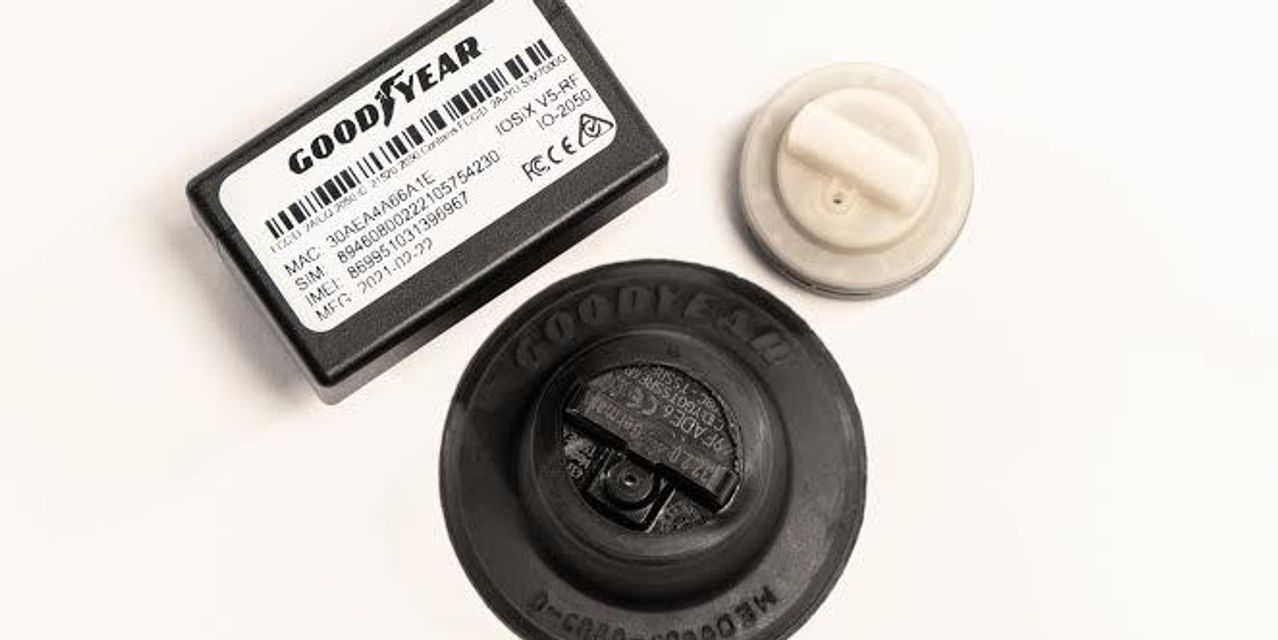Alongside the tire jack and the air pump, consider the algorithm as a tool for fixing flats.
Goodyear Tire & Rubber Co.
and
Bridgestone Corp.
are rolling out new intelligent tire features that use sensors and artificial intelligence for vehicles delivering packages from e-commerce sites such as
Amazon.com Inc.
The technology is geared toward vehicles that specialize in last-mile delivery, which refers to the final step in getting packages from a distribution center to the customer. The market for last-mile delivery has picked up as online shopping has soared during the coronavirus pandemic.
Goodyear’s new technology, announced Wednesday, is called SightLine and includes a sensor and proprietary machine-learning algorithms that can predict flat tires or other issues days ahead of time, by measuring tire wear, pressure, road-surface conditions and many other factors.
The surge of last-mile deliveries during the pandemic means that a lot of vehicles are on the road, “stopping and going, hitting curbs, causing damage to the tires, causing breakdowns and congestion,” said
Richard Kramer,
chief executive of Akron, Ohio-based Goodyear.
The last-mile delivery market is expected to grow to almost $70 billion by 2025, up from about $40 billion in 2020, according to technology research firm
Gartner Inc.
The volume of parcels is expected to grow to 200 billion in 2025, up from an estimated 100 billion in 2019, according to Gartner.
In a pilot test with about 1,000 vehicles operated by 20 customers, including some of Amazon’s delivery service partners, SightLine was able to detect 90% of their tire-related issues ahead of time, said
Chris Helsel,
Goodyear’s senior vice president of global operations and chief technology officer.
SightLine builds off sensor technology that has been in the works for several years. Goodyear already sells tires to large commercial trucking customers that can measure temperature and pressure, but the SightLine system contains more advanced technology, Mr. Helsel said, including a sensor that tracks dozens of measurements such as tire wear, inflation and road-surface conditions and a battery that detects temperature, pressure, acceleration and vibration.

Goodyear CEO Richard Kramer
Photo:
Goodyear Tire & Rubber Co.
The system also includes a device that ingests data and communicates with Goodyear’s cloud, which analyzes the data in real time using proprietary machine-learning algorithms, Mr. Helsel said.
Vehicles using Goodyear’s intelligent tires can shorten the stopping distance lost by wear and tear on a tire by about 30%, he said.
Last-mile delivery vehicles can go through four sets of tires a year, which is highly inefficient from a cost and sustainability perspective, said Nizar Trigui, CTO at Nashville-based Bridgestone Americas, a subsidiary of Bridgestone Corp.
The company, which has historically focused on customers in the long-haul trucking sector, is developing an intelligent tire system that uses sensors, AI algorithms and “digital twins,” which are digital representations of physical tires on vehicles, to predict when tires will wear out on delivery vehicles and whether the tires are still in good health for retreading. Putting a new tread on a used tire that still has life in it is better for the environment than sending it to a landfill, Mr. Trigui said. Compared with new tires, retreaded tires reduce carbon emissions by 24% and reduce air pollution by 21%, according to the company.
The technology is currently in the final stages of testing with last-mile delivery partners and will launch in the coming months, Mr. Trigui said.
Bridgestone Americas already has several intelligent tire features available for customers in the mining and commercial trucking industries.
Helping detect tire-related problems before they happen can lead to fewer breakdowns, less traffic congestion and increased safety for last-mile delivery drivers, said Bart De Muynck, vice president analyst at Gartner’s supply chain practice.
Tire manufacturers are investing more heavily in the field of telematics, which refers to the use of technology to collect and monitor data relating to a vehicle or parts of a vehicle, he said.
Telematics is expected to become an important part of electric vehicles and self-driving cars in the future, to get more information about a vehicle’s maintenance status, emissions and safety at any given point in time, he said.
Making drivers aware of potential tire-related problems ahead of time makes good business sense, too, he said, since drivers will pay to get tires serviced. Large portions of tire makers’ revenue is now coming from the services side, as people are buying fewer cars overall. “Having access to the data, not just when you make the product but when you sell it [will] allow you to serve your customers on an ongoing basis,” Mr. De Muynck said.
Write to Sara Castellanos at sara.castellanos@wsj.com
Copyright ©2020 Dow Jones & Company, Inc. All Rights Reserved. 87990cbe856818d5eddac44c7b1cdeb8













































